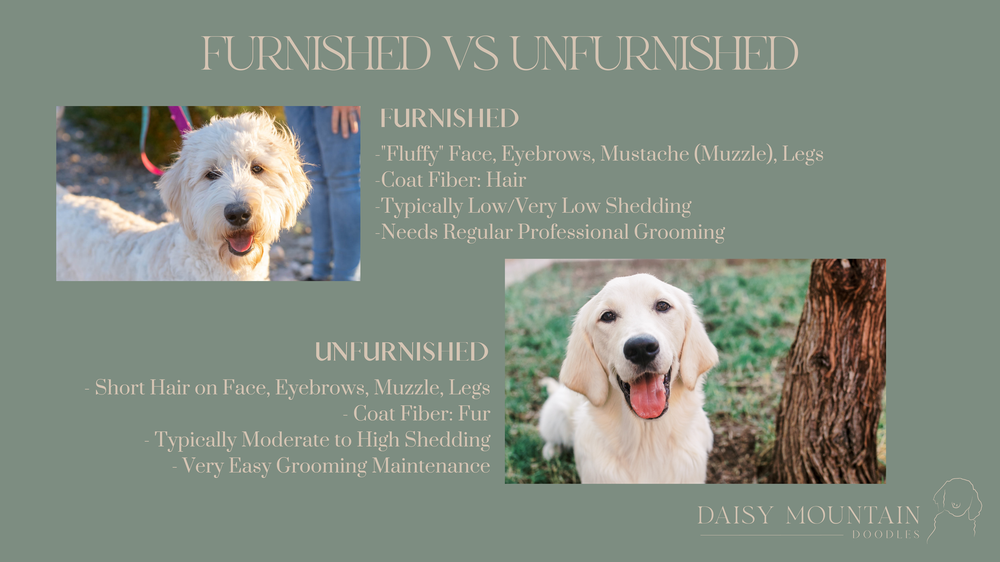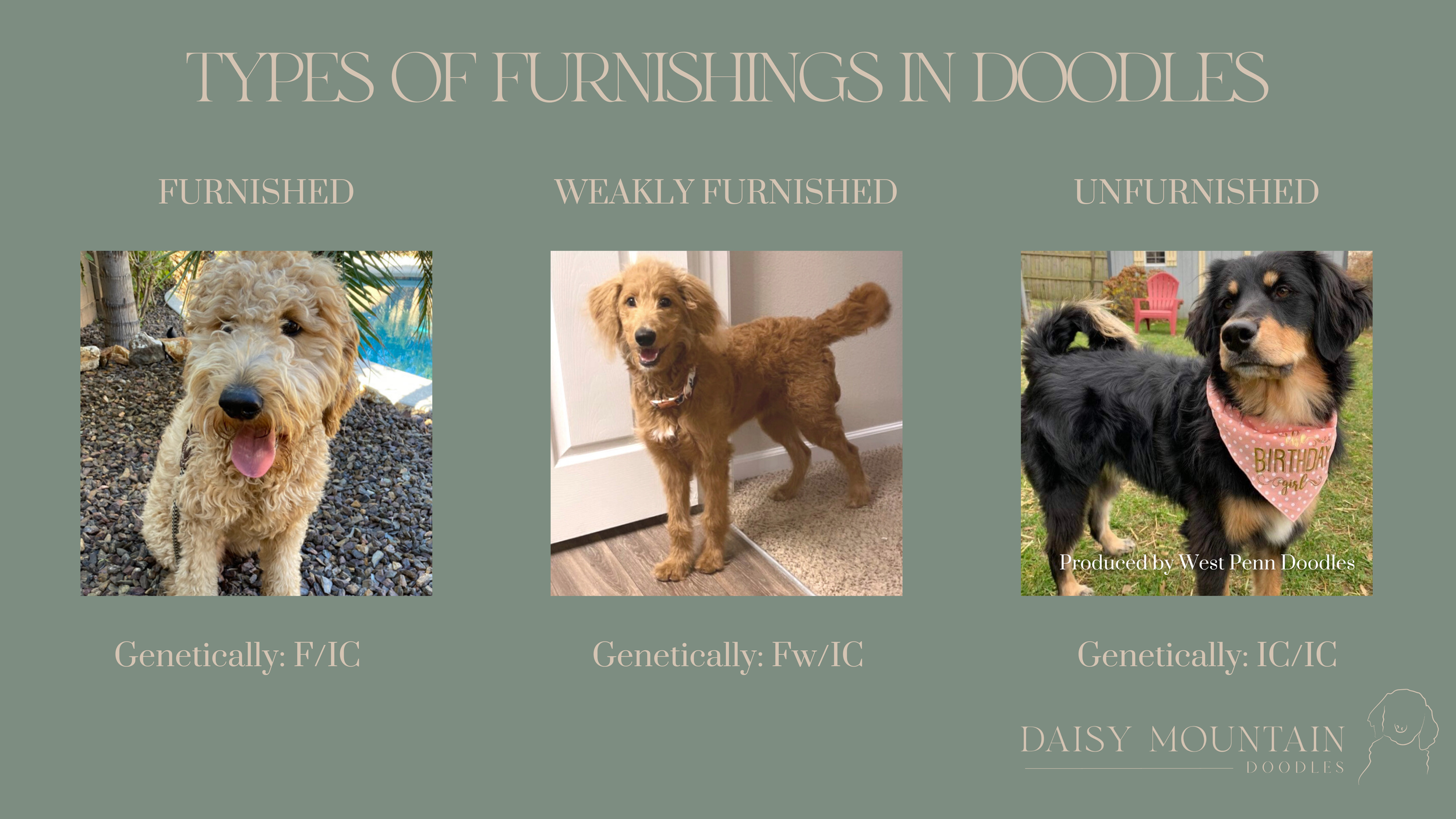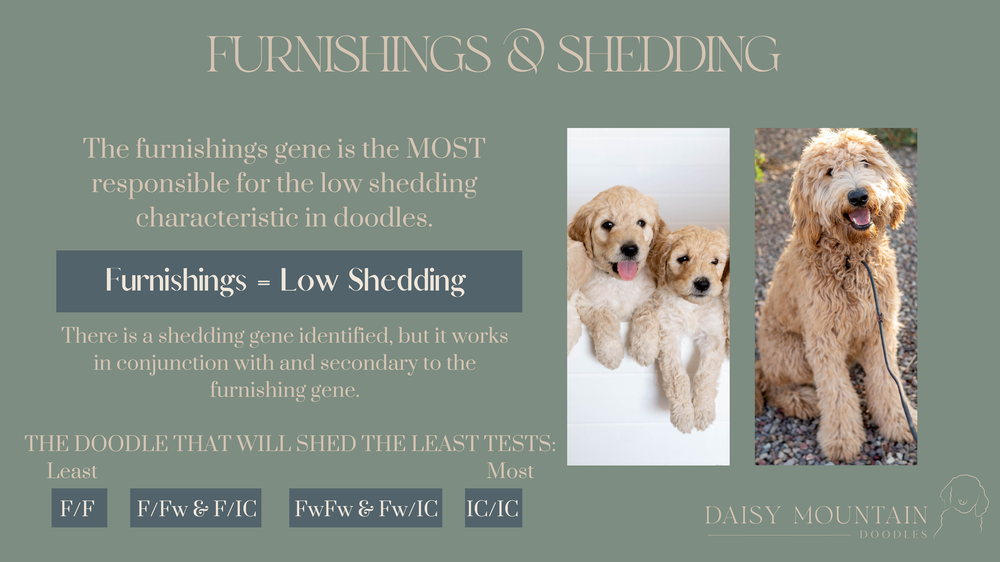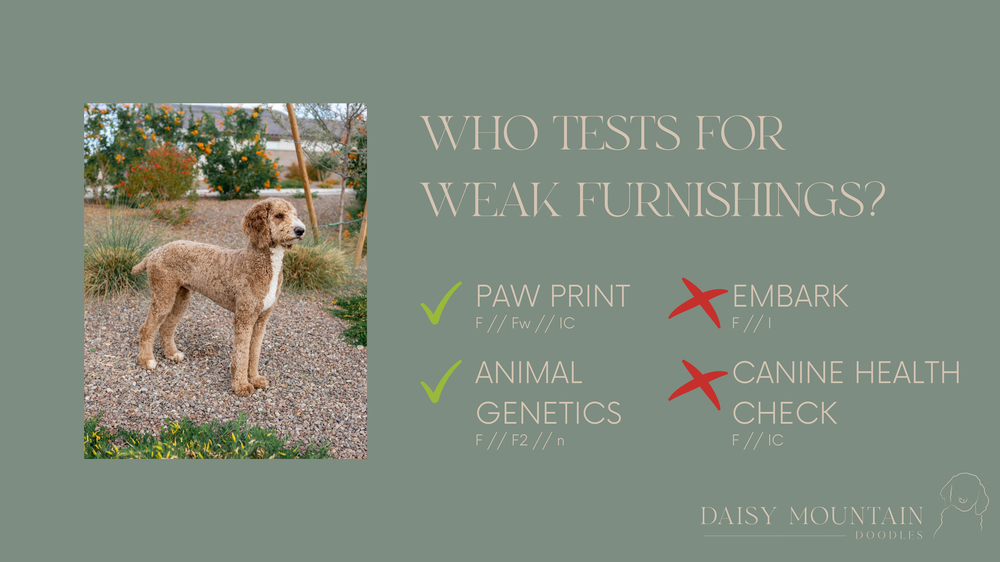All About Furnishings in Doodles and Poodles
What makes doodles look the way they do? Why are doodles and poodles better for mild to moderate allergies? Why don’t poodles and doodles shed as much? These answers are some of the reasons why doodles, and poodles, are becoming so popular with so many people! Doodles and poodles are diverse in their colors and looks - doodles can come in curly, wavy or straight coats (determined by a curl gene), doodle and poodle colors can change and fade or get darker (untestable genes at the moment), coats can go through coat texture changes periodically their first year to two (puppy coats developing into adult coats). There are a lot of genes that we know make up all these characteristics, and a lot we don’t know…yet (fingers crossed we continue to get more and more info as the years go on). One big characteristic of doodle and poodle coat that is important to know about is the furnishing gene. It’s important to know about gene itself, and how that gene interacts with others, when picking out your doodle or poodle! Here are some considerations.
What are furnishings?
On a high level, furnishings are responsible for the fluffy/fuller muzzle/mustache and eyebrows on a dog.
Another characteristic of the furnished coat is that the coat fibers are made of hair instead of fur, which also adds to the “fluffy” characteristic in a furnished dog, and have varying degrees of feeling wiry-haired. Like in humans, doodle and poodle hair will continue to grow, so that is why they need to be professionally groomed and trimmed every 6-8 weeks maintain the coat and prevent matting. In contrast, non-furnished dogs (for example golden retrievers or Bernese mountain dogs) are characterized by very short facial fur, no mustache or eyebrows, short fur on the legs, and a coat that sheds its fur cyclically and seasonally.
Furnishings are in the breed standard for doodles and poodles, so we expect them to look “fluffy.” There are many other factors that combine together to give the overall coat type and look in doodles and poodles, so not all furnished dogs look exactly the same. Some have either straight, wavy or curly coats, some have more wiry hair texture or softer hair texture, and as we will discuss further, there is a spectrum and some can have weak furnishings or even an improper/flat coat (no furnishings). We’ll talk more about this later, but here is an example of each.
Genetic Speak: Geneticists know that variants on the RSPO2 gene are responsible for the furnishing/improper coat on the furnishing gene/IC locus. Currently, there are 3 variants that we know of:
Furnished, results most commonly given as F
Unfurnished/Improper Coat, results are given as I (Embark), IC (Pawprint), n (Animal Genetics)
Weakly Furnished, results are given as Fw (Pawprint) and F2 (Animal Genetics)
*Pawprint’s nomenclature will be used from here on out.*
The dominance of the genes are as follows: F is the most dominant, and only needs one allele for a doodle to look furnished. They can have any of these results: F/F, F/Fw, F/IC. Fw is less dominant than F, but more dominant than IC, so an Fw/Fw or Fw/IC dog will look weakly furnished (more about this further in the blog). A doodle that looks improper/flat coated will be IC/IC.
Breeder’s Edition: There are many labs that can test for furnishings so you can know what your breeding parents have, and what possibilities their puppies can have! Embark, Canine Health Check, Pawprint, and Animal Genetics are the most common but it is imperative to note, there are some important differences that we will discuss further in this blog!!! Of course once you know your breeding pair’s data, you can use your good ol’ punnett square to figure out the possibilities for your puppies. If you take an F2 pairing for example, each parent is typically F/IC so your punnett square shows that each pup has a 25% chance to be F/F, 50% chance to be F/IC, and 25% chance to be IC/IC. Since F is dominant, then we can interpret that each pup has a 75% chance to look furnished, and 25% chance to look unfurnished.
How do furnishings affect the coat?
As mentioned before, furnishings play a big part in how a doodle looks, and gives them their fluffy look with a mustache and eyebrows. But here is the cool part about furnishings, they have the biggest contribution to doodles being low shedding! Let me say it again, the furnishings gene is the most responsible for the low shedding characteristic in doodles!! There is a separate shedding gene that has been identified, and in unfurnished breeds like golden retriever and bernese mountain dogs, that plays the biggest role in determining if they are a high shedder or moderate shedder. In doodles, the shedding gene still plays a role but it is in combination with, and secondary to the furnishing gene. If one of your priorities in having a doodle is to be as low shedding as possible, you want to look for a doodle that has double furnishings and double low shed genes.
Also, doodles can be good for individuals with mild to moderate allergies, and that also has to do with these furnishing characteristics. First, it is important to know that dog allergies can be triggered by dog hair, dog dander, or dog saliva. If your allergies are triggered by dog hair or dander, then a furnished doodle could potentially be a good fit since they are low shedding due to the furnishing gene and may have less dander, generally speaking, because of that as well.
Genetic Speak: Pawprint has a great description and chart of how the shedding gene interacts with the furnishing gene. The description is here and the chart is below:
Breeder’s Edition: As breeders, we can use testing of our puppies to help pair puppies with clients that have more concern about allergies. For clients wanting the most hypoallergenic option, we can use testing to help them find an FF pup with the least amount of shedding genes.
What is important to know about weak furnishings?
As mentioned a couple times in this blog so far, currently there is a distinguishing factor in the furnishing gene between what is called furnishings and weak furnishings. On a high level, weak furnishings are what they sound like and have a less “fluffy” coat and a weaker look around the mustache, eyebrows, and legs. There are also some other characteristics that are important, and they can be a little more unpredictable. A weakly furnished doodle may shed a little more than a furnished doodle, but typically may not shed more than an unfurnished doodle or unfurnished breed. They can have a soft coat due to really fine hairs, or a little more wirey haired coat, or anything in between. Also, a weakly furnished dog will most likely need less grooming maintenance and may mat less (which can help the pocketbook a little)! Here is a series of photos that show the difference:
Genetic Speak: Currently, when testing for furnishings, geneticists can distinguish between two variants: furnishings and weak furnishings. Not all labs can test for this, and the most common labs that can are Pawprint and Animal Genetics. So for an example, a dog that test FI on Embark can either be F or Fw, they can not distinguish between the two, whereas PawPrint and Animal Genetics will be able to tell you if that dog is truly F/IC (F/n), or Fw/IC (F2/n).
*It is important to note - I think there are still more untestable factors that play into furnishings, so I suspect we will continue to learn more about these genetics as scientists continue to discover more currently unknown genes. First, there seems to be a spectrum (or perhaps a combination of currently unknown genes) with furnishings. Even with dogs that test F, there seems to be a range of “fluffiness” where some are more fluffy than others. And also with dogs that test Fw, there seems to still be a range as well.
Breeder’s Edition: Embark, Canine Health Check, Pawprint, and Animal Genetics can test for furnishings, but there are some important differences to note!!!
Embark includes furnishings in their test/results, but they only use a linkage test for furnishings, and it does not distinguish between furnishings and weak furnishings - they both show up as F in the results. Both Paw Print and Animal Genetics can test for all three variants: furnishings, weak furnishings, and improper coat. Canine health check, although owned by Paw Print, also uses linkage information when testing the furnishings gene, so both furnishings and weak furnishings show up the same as F and does not distinguish between the two, and unfurnished shows up as IC. As breeders, I urge us to test furnishings through Paw Prints and Animal Genetics so we can have the most information when making breeding decisions. Since being furnished is breed standard, I urge breeders to disclose to clients when their pup is weakly furnished or flat coated so they know their pup is in a different niche group, and educate them on the pros and cons of weakly furnished or improper/flat coated puppies. Some clients seek these characteristics out, and we just need to help educate clients and give them options.
What to know about Doodle puppy coats
Puppy coats can be very unpredictable in doodles. In a doodle that is tested with at least one “F,” generally they look fluffy and soft, then around 8-9 months (typically) they transition into their adult coat and they can experience some shedding during this time, as well as some roughness (the adult guard hairs come in first and are longer and more coarse), then you will see their adult coat traits they will have thereafter (wavy/curly, level of fluffiness, any amount of shedding they end up with, etc) after the transition. In a doodle that tests as “Fw,” their facial puppy hair, and leg hair will look sparse and wispy, then around 8-9 months (typically), their adult coat will start to come in. At 12+ months, you will have a good sense of what your weakly furnished dogs coat traits will be, how much “fluffiness” they will have on their muzzle, eyebrows, and legs, the level of shedding they will have, if the coat is more finely soft (this will be most typical), or has some coarseness to it.
But to speak to the unpredictability, I know there are puppies out there (there have been a few pups produced in my program) where we know they are “F,” not “Fw,” but sometimes their puppy coat acts and looks as though they were weakly furnished at first, but ended up looking normally strongly furnished once they lose their puppy coat around 8-9 months, and get their adult coat in. As of right now, there are no genetic tests that can explain or predict this. So doodle puppies from 4-8 months can have a spectrum of fluffiness in their puppy coats/faces, even in they are “F” or “Fw,” and the only way know they are truly Fw is through a test from Paw Prints or Animal Genetics.
Examples of Furnished, weakly furnished, and unfurnished doodles
Below are examples of doodles with various furnishings. If you have a doodle with weak furnishings or is unfurnished and are willing to share with me to use on here, please message me! Thank you!






